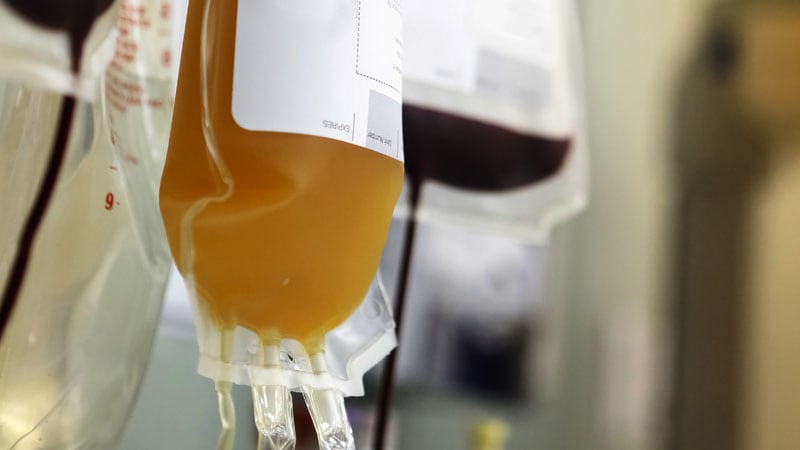Prehospital plasma, administered soon after injury, appears to improve survival for patients with traumatic brain injury (TBI), results of a new analysis suggest.
Administration of prehospital plasma demonstrated a strong survival benefit and was associated with a 45% lower risk for mortality in TBI patients, Danielle S. Gruen, PhD, and colleagues write in their report, published online October 15 in JAMA Network Open.
The finding is from a post hoc secondary analysis of a prespecified subgroup from the Prehospital Air Medical Plasma (PAMPer) randomized clinical trial, published in 2018 in The New England Journal of Medicine.
PAMPer studied the safety and efficacy of prehospital administration of thawed plasma in injured patients at risk for hemorrhagic shock. It included 501 patients; 230 received prehospital plasma, and 271 received standard-care resuscitation that did not include prehospital plasma administration.
Results showed that mortality at 30 days, the trial’s primary endpoint, was significantly lower in the plasma group than in the standard-care group (23.2% vs 33.0%; P = .03).
The current analysis explored the association between prehospital plasma resuscitation and survival in a subgroup of 166 patients with TBI. Of these, 74 patients received prehospital plasma, and 92 received standard care.

Dr Jason Sperry
“If you give prehospital plasma to injured patients, there is a survival benefit, as PAMPer showed, and the current study demonstrates that the signal is strongest in patients who have traumatic brain injury,” senior author Jason L. Sperry, MD, MPH, professor of surgery and critical care, University of Pittsburgh Medical Center, Pittsburgh, Pennsylvania, told Medscape Medical News.
“We think that giving plasma as soon as possible improves survival via several mechanisms,” he said. “These include volume expansion to restore perfusion, an alteration in the inflammatory response, a reduction in endothelial injury, and the prevention or mitigation of coagulopathy.”
The median age of the patients with TBI was 43 years (range, 25 – 60 years). Brain injury was shown on CT imaging. Most patients with TBI were men (n = 125, 75.3%), and all had blunt trauma injuries. The median Injury Severity Score was 29 (interquartile range [IQR], 22 – 38).
Patients with TBI were more severely injured than those without TBI, and the incidence of prehospital intubation was higher for those patients. In addition, they were more likely to receive in-hospital vasopressors, the length of stay in the intensive care unit was longer, they spent more days on mechanical ventilation, and 24-hour mortality rates (P = .001) and 30-day mortality rates (P = < .001) were higher.
Except for the plasma intervention, there were no significant differences in fluid administration during transport to the hospital. However, in-hospital transfusion requirements differed between the two groups. Patients with TBI who were treated with prehospital plasma received less crystalloid fluid, vasopressors, and packed red blood cells in the first 24 hours.
In addition, for patients with TBI who received prehospital plasma, international normalized ratios were lower (median, 1.20 [IQR, 1.10 – 1.40] vs 1.40 [IQR 1.20 – 1.80]).
The association between survival and administration of prehospital plasma in the TBI subgroup was statistically significant, with a 45% lower risk for mortality (hazard ratio [HR], 0.55; 95% CI, 0.33 – 0.94; P = .03).
The analysis also found there was no significant association with survival among injured patients without TBI who received prehospital plasma (HR, 0.67; 95% CI, 0.39 – 1.14; P = .14).
For patients with TBI whose Glasgow Coma Scale (GCS) score was <8, administration of prehospital plasma was also associated with survival benefit. For those patients, the risk for mortality was reduced by 44%. Among patients with TBI and polytrauma, there was a 50% reduction in mortality risk.
For patients who received plasma at the scene of injury, survival was improved (HR, 0.45; 95% CI, 0.26 – 0.80; P = .005). However, for patients who were transferred from an outside hospital, there was no difference in survival when given plasma (HR, 1.00; 95% CI, 0.33 – 3.00; P = .99).
“The earlier you give plasma, the better,” Sperry said. “Sometimes patients get picked up by helicopter at the scene of the accident, and this analysis shows that their survival is better if they are given plasma in the helicopter en route to hospital.”
For patients who were brought to a hospital that did not have the facilities to treat them and who were then transferred to a trauma center where they then received plasma, there was no survival benefit, he said.
“So the signal in this current study is that in patients who have traumatic brain injury, the earlier you give it, the closer to the time of injury, the more beneficial it is,” Sperry concluded. “You don’t know in the helicopter if the patient has TBI, but it is still worth it to give the plasma.”
PAMPering the Brain
In an invited commentary, Robert H. Bonow, MD, from the Department of Neurological Surgery, University of Washington, Seattle, writes: “Given the extensive global burden of TBI, interventions that improve outcomes have the potential to make a substantial impact on public health. Unfortunately, despite decades of research and promising preclinical studies, few trials have demonstrated meaningful benefits in humans with TBI.”
This study is important, he said, “because it shows that a routinely available intervention may be associated with substantial improvement in TBI survival.”
Although it provides evidence that prehospital plasma administration improves survival for patients with TBI and multiple traumas, “the study is subject to the usual limitations of secondary analyses of randomized clinical trials,” he notes.
Bonow adds that the study raises several questions. An important one is whether prehospital plasma improves neurologic recovery among survivors.
“Some interventions that have shown survival benefit in patients with severe head injury do not improve the likelihood of good neurologic recovery, and instead increase the odds of surviving with severe disability. These types of interventions raise ethical and cultural issues that require careful consideration,” he writes.
Another is whether plasma truly is of no benefit for patients with trauma who do not have TBI.
“These issues warrant deliberation as trauma systems contemplate the routine use of prehospital plasma in this population,” Bonow concludes.
The study was sponsored by the Department of Defense. Sperry and Bonow report no relevant financial relationships.
JAMA Netw Open. Published online October 15, 2020. Full text, Commentary
For more Medscape Neurology news, join us on Facebook and Twitter.
